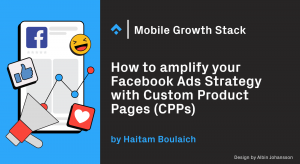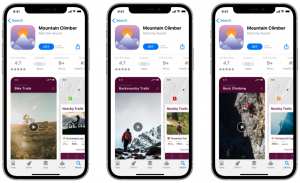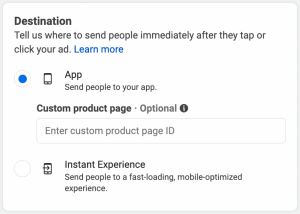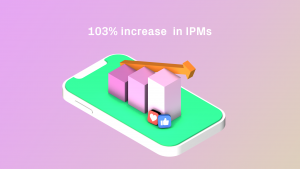
One of the biggest pieces of in-app marketing news last year was the emergence of Custom Product Pages. Custom Product Pages (CPPs for short) are unique landing pages in the App Store intended for user acquisition; they enable you to show different facets of the app while maintaining consistent messaging and a seamless experience throughout the user acquisition journey; from the performance marketing channels to the App Store experience. CPPs entailed the end of single App Store pages per storefront. Since mid-August 2022, Facebook Ads also offers the possibility to direct traffic to a specific Custom Product Page. From the tests we’ve run so far, we noticed a substantially higher Install Per Mille by using this functionality – 103% higher! Install Per Mille in this instance is defined as the conversion rate between impressions and installs.
This article will explain how to drive traffic to Custom Product Pages with Facebook Ads, the benefits of using them in this acquisition channel (including results from our recent tests), considerations for their setup, as well as our own setup recommendations. To inform yourself about the general guidelines to set up Custom Product Pages in the App Store and integrate them in Apple Search Ads, please check our other article on the topic: Custom Product Pages with Apple Search Ads, How and Why to Use Them.

Examples of Custom Product Pages. Source: Apple
Results and use cases
Each Custom Product Page has a unique URL which can be integrated into Facebook Ads and used to direct traffic from a particular ad to a specific CPP. Please note that CPPs are not accessible to the users when they search organically, only through the unique URL that can be embedded in your performance marketing campaigns, or in the App Store editorially curated selections on the ‘Today’, ‘Games’, and ‘Apps’ tabs.
CPPs enable you to direct traffic from an ad targeted by audience, interest or theme to a Custom Product Page with creatives that are consistent with that targeting. This maximizes the alignment of audience + creative + app store experience; the audience will find the landing page more relevant. Consequently, CPPs offer a consistent and seamless experience from start to finish in the user acquisition journey, resulting in higher conversion rates. From the initial tests that we’ve run, we observed drastically higher IPMs (conversion rate between impressions and installs) with CPPs in Facebook Ads, up to 103%!
The higher conversion rate doesn’t come as a surprise as the user finds each step of the funnel, from impression to install, more relevant.
These results could be replicated with several use cases of Custom Product Pages:
- Showcasing different features of the app (e.g., yoga vs. HIIT workout on a fitness app + target yoga and HIIT workout audience interests respectively + aligning the ad creatives respectively ).
- Targeting a specific demographic (e.g., a clothing app showing a different CPP for women vs. men + aligning the adset demographic targeting and ad creatives respectively)
- Leveraging seasonal campaigns (e.g., a Black Friday Custom Product Page + specific scheduling on the adset level + ad creative).
- Directing returning users to a Custom Product Page with a focus on new app features.
- Directing traffic to a CPP that is geographically more relevant to specific users (e.g., a delivery app operating in Berlin could direct traffic from Berlin to a CPP with creatives that showcase Berlin).
Where to find the CPP functionality in Facebook Ads
In Facebook Ads the integration with the Custom Product Pages happens at the ad level; there, under ‘Destination’, you can put the URL of your Custom Product Page and direct traffic to it instead of the Default Product Page. For the record, if you input there another URL that doesn’t correspond to a CPP, the user will be directed to the Default Product Page.
The setup to make the most out of the Custom Product Pages starts at the adset level. There you can choose to target the specific audiences you would like to leverage, in order to give them a seamless experience from start to finish through the conversion funnel. Furthermore, we recommend setting OS targeting in the adset level to iOS +15, as CPPs are only available for devices using iOS 15 and higher.

On the ad level under ‘Destination’ you can put the link to the Custom Product Page and choose to direct traffic there instead of the default App Store product page. Source: Facebook Ads Console.
Set up structure: considerations and recommendations
Regarding the best campaign structure to drive traffic to CPPs in Facebook Ads, there are several things to consider:
- For iOS campaigns in Facebook Ads you will be using Apple’s SKAdNetwork API for attribution. The SKAdNetwork is a set of software and protocols created by Apple that allow marketers to get deterministic but aggregated attribution of mobile app marketing campaigns while protecting the user’s privacy.
- With SKAN you are not able to see post-install conversions on an adset and ad level, only on a campaign level. Moreover, you need a certain volume of installs per day on the campaign level to pass the privacy thresholds. In Facebook Ads you need 88 app installs per campaign per day to be able to view the conversions coming from that traffic.
- You have to consider how many campaigns you need as the number of iOS campaigns you can run on Facebook is limited. Facebook stipulates “you can run up to 9 iOS 14+ app campaigns across up to nine ad accounts per app ID. The total number of app campaigns across ad accounts is limited to nine app campaigns. For example, if an advertiser wants to run iOS 14+ campaigns from nine ad accounts, they can only have one campaign per ad account.” (Source: Facebook)
- Another thing to consider is App Tracking Transparency (ATT). ATT is a change to Apple’s privacy and data collection policy that requires mobile marketers to ask consent from users in order to track them. Marketers can choose to show an in-app pop-up that asks users to give or deny access to their device identifier (the IDFA) as part of an opt-in mechanism. This is a way of sidestepping SKAN privacy challenges. Please take into account that ATT has to be consented in both the app and the ad network (Facebook Ads in this case) for the advertiser to get the IDFA. Furthermore, the ATT prompt may disrupt the user experience and may lead to higher drop-off rates.
- Facebook gives a shot at calculating post-install conversion on the adset and ad level using statistical modeling and displays conversions directly in the console, more information about that here.
Taking the previous points and your marketing objectives into account you can make an informed decision on which compromise you can afford to take, and choose the right campaign structure for your needs :
- For example, if you choose to have your CPP adset in a campaign with other adsets, you will not be able to access post-install data of this adset. This is because SKAN doesn’t show post-install data on adset level. However, you will be able to find statistically modeled post-install data for this adset built by Facebook in the console itself.
- If you choose to have your CPP adset in a single adset campaign to have more accurate post-install data, you’ll run into the challenge of that single adset needing to acquire 88+ installs per day or you will not have conversion visibility of that traffic. Furthermore, the number of iOS campaigns you can run on Facebook will be limited.
- If you choose to show the ATT prompt to sidestep SKAN privacy challenges you may disrupt the user experience, leading to potentially higher drop-off rates. Moreover, users will need to opt-in in both the app itself and in the ad network for you to get the IDFA.
Deciding on your structure
All the different options come with their own pros and cons. It is up to you to make the decision based on the specific trade-off that you want to have. Our recommendation would be to run the CPP adset in a single adset campaign, if you are not limited by the number of campaigns you would like to run and have enough budget to pass the 88 installs per day threshold.
Most apps struggle with the efficiency of Facebook Ads due to the outbound marketing nature of the channel. Custom Product Pages will enable you to better contextualize the user journey of the audiences you target. As a result users will find the initial steps of the funnel (from impression to install) more relevant. This will consequently improve conversion rates. For the record, Custom Product Pages can be leveraged to direct traffic from other advertising channels, such as Apple Search Ads, not only from Facebook Ads.
In conclusion, engaging and experimenting with Custom Product Pages enables you to properly contextualize the full user journey and can be an extremely valuable tool. Not embracing CPPs amounts to a lost opportunity from your side, and instead an opportunity that your competitors may very well take advantage of to improve their own user acquisition.
Before You Go
- If you need specific advice on CPPs, you can reach out to us here and one of the Phiture team will be in touch!
- Check out our original blog article detailing the launch of CPPs and the App Store.
- Please make use of our Mobile Growth Stack Slack community to ask us any other questions and we’d love to answer them where we can.













